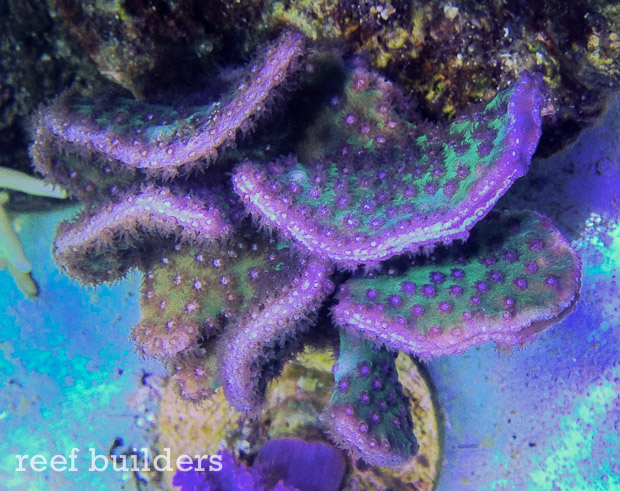Turbinaria bifrons is quite simply unlike any coral anyone has ever seen, and it is perhaps one of the rarest stony coral species in the aquarium hobby. When we say T. bifrons is rare we don’t mean rare as in a strain of a particular highly desired Echniophyllia, a genus that is practically overrepresented in aquaria.
No we mean this coral is rare as in we’ve only seen it twice, the first time being more than seven years ago and only one other time more recently at MACNA. Furthermore there exists scantly no more images of the unusual “two-face” Turbinaria than what is included in the Veron’s Corals of the World.
 So if this corals is so rare and overlooked why should we or anyone care? What makes T. bifrons unique is that instead of growing single-sided plates like the cup corals we are most familiar with, or having a branching shape like the coveted Hero coral, T. heronensis, T. bifrons has upright blades which are bifacial, that is with corallites growing on both sides of the “branch”.
So if this corals is so rare and overlooked why should we or anyone care? What makes T. bifrons unique is that instead of growing single-sided plates like the cup corals we are most familiar with, or having a branching shape like the coveted Hero coral, T. heronensis, T. bifrons has upright blades which are bifacial, that is with corallites growing on both sides of the “branch”.
Turbinaria bifrons is one of only two species in the genus to display this clear-cut distinction of having corallites on both sides of its upright plates. The other species being Turbinaria conspicua, which was once synonymized with T. bifrons, making it all the more confusing in terms of taxonomy, but you don’t need to be a coral taxonomist to appreciate this coral’s incredibly unique growing shape.

Having once acquired a piece of T. bifrons so long ago, this species is one that has been on our rare-coral radar for years but in an interesting turn of events, it was the coral that found us! While perusing the many coral tanks at MACNA earlier this year in Denver, Orlando Salazar of Aqua Medic Live brought us over to the display of Carolina Aquatics to test our coral knowledge.
By some second nature we instinctively knew we were looking at a nice spread of corals hailing from Darwin in West Australia – this ecoregion is home to such coral hits as wild Acropora solitaryensis, tricolor Micromussa and the jaw-dropping branching Favites complanata. Even the chalice corals from Darwin look really distinctive and Carolina Aquatics had a boat load of them, but the real treasure in the bunch was a dark brown semi-erect growing stony coral that at first glanced resembled a medium branched species of Pavona.
 Closer inspection of the unusual coral revealed that the corallites were recognizable as being those of a Turbinaria and seeing them on both sides confirmed that this was indeed a colony of the T. bifrons we sought after for so many years. Luckily since the coral was devoid of color and its true potential was unknown to coral collectors besides ourselves and Julian Sprung, Carolina Aquatics put a fair price on this colony so that the coral could go to a good home.
Closer inspection of the unusual coral revealed that the corallites were recognizable as being those of a Turbinaria and seeing them on both sides confirmed that this was indeed a colony of the T. bifrons we sought after for so many years. Luckily since the coral was devoid of color and its true potential was unknown to coral collectors besides ourselves and Julian Sprung, Carolina Aquatics put a fair price on this colony so that the coral could go to a good home.
Our experience with the easy bleaching potential of Turbinaria heronensis imparted on us a very cautious approach to lighting up this coral and we took several weeks to move it into more or less direct lighting. Now more than three months since acquiring the coral, it has settled into captive aquarium life and its relative beauty is much easier to appreciate.
 Our colony of Turbinaria bifrons has settled into a nice but not flashy forest green color with pinkish polyps that have a whitish oral disc. The edges of the bifacial plates are light brown bordering on pink and where the edges face the predominant flow, you can easily see two rows of corallites where the coral is growing fastest.
Our colony of Turbinaria bifrons has settled into a nice but not flashy forest green color with pinkish polyps that have a whitish oral disc. The edges of the bifacial plates are light brown bordering on pink and where the edges face the predominant flow, you can easily see two rows of corallites where the coral is growing fastest.
At the moment, one of the only colonies of T. bifrons in captivity is about fist sized and showing a really neat branching-blade shape. Seed frags have been made and will soon be distributed to fellow reefers so we can secure this coral’s presence in the aquarium hobby, learn more about its preferred conditions, and most exciting of all, see how many different ways this species can grow in reef aquariums.
Huge thanks to Carolina Aquatics for parting with this coral for a reasonable price, and as an intact colony showing all the species’ characteristics. The two-face T. bifrons is not likely to win any beauty contests against “designer corals” but we will do our best to ensure that this strain lives on in the aquarium hobby so that the diehard stony coral junkies can partake of it in the future.



